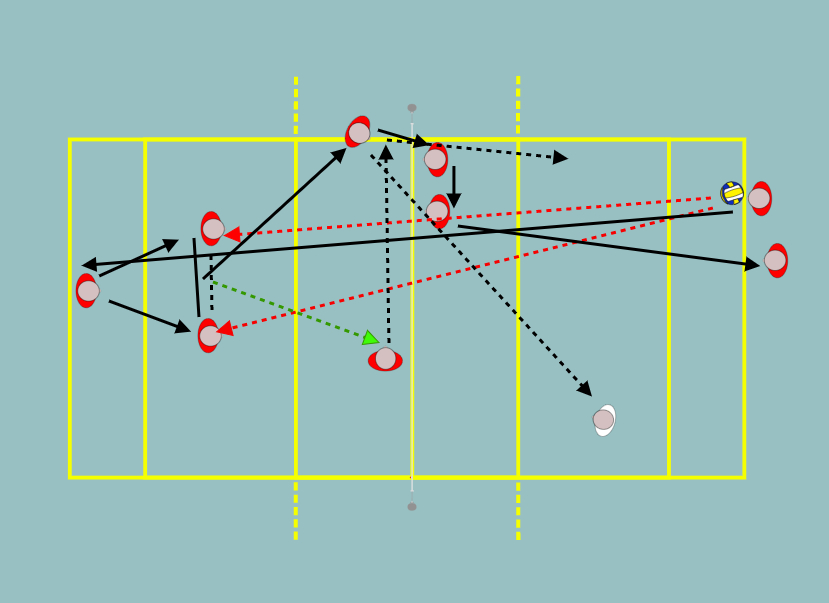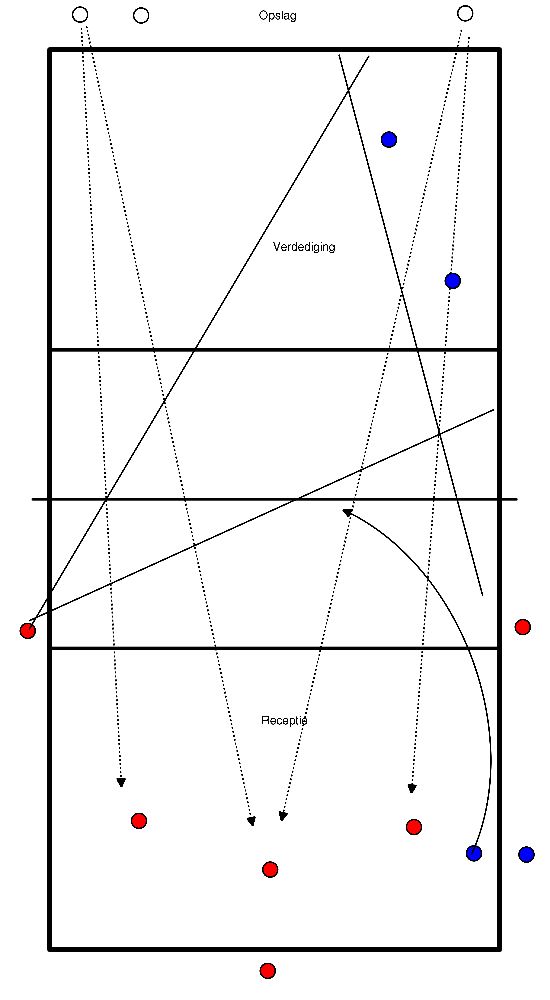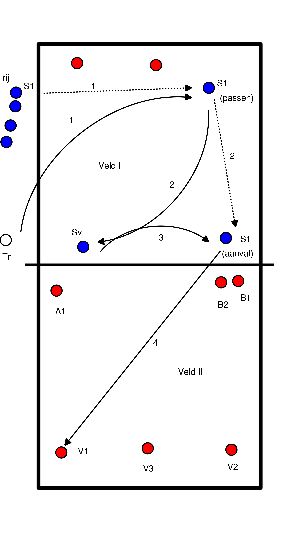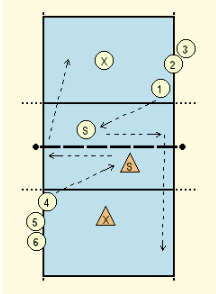Volleyball drills for technique defense / passing / digging / diving / reception
- Bunch of two balls
- one sits on his knees on the ground the other goes from left to right
- after a while change
- Both sides set up a team, normal game line-up.
- Trainer throws ball into the backfield, team defends and builds up attack, opponent idem, ball is introduced by trainer where mistake is made.
- Quick switching, lasting rallies and no delays as a result of service.
- Regularly turn at the indication of the coach.
- Feet at shoulder width
- hands and arms point outwards start in a good starting position
- bend the knees most of the power comes from there
- body and feet point to the direction of play
- arms remain stretched next to each other and are brought together just before the ball
- the contact area is the forearms
- Make groups of 3,
- One player stands at the back line with the ball to serve,
- the other two players move to the other side of the net.
- The first player is going to serve, the other two are going to defend and call.
- The player not defending runs forward and catches the ball.
- It is rolled to the player who defended and the player who caught goes under the net to the player who saved.
- It goes on like this all the time.
- Building up with a pass and possibly attacking.
- If the ball falls between the players or falls without being called, as punishment sit-ups or pumps.
- 5 (or minus 4) players per side of the field, with 1 ball.
- 4 players stand in the field and 1 player stands at the back line with the ball.
- The 4 players in the field are lined up and the player at the back line of the other side is going to pass the ball over the net (overhand or underhand does not matter for this exercise, but the ball must be over the net!)
- The players are going to defend this ball to the player who gives the pass (this one is run in from position 1).
- This player catches the ball above his head and gives a high pass.
- The ball is caught at the net (no attacking).
- The ball then goes to the server.
- The same exercise is done but now with the other side of the court. After this it is back to the first side to serve.
- So there is one place rotated.
- After a while the same exercise can be done with an attack (key over the net) where it is important that when the attack is done over the net player 1 and 3 exchange places!!!!!!!
- The team is divided into 2 groups (4 according to the amount of players).
- team 1 = storage team
- team 2 = catch team
- Team 1 serves 1 for 1.
- They start close to the net and when they succeed they can move further and further away.
- Team 2 forms a line on the opposite side behind the back line.
- When player 1 of team 1 serves, player 1 of team 2 comes in the field to catch the ball.
- He catches the ball and walks outside the square to team 1 to serve and joins the back of the line.
- The server walks outside the square to team 2 to catch the ball and joins the back of the line.
- There are 6 players standing with their backs to the net, three on each side.
- A stands on the back line,
- the first player throws the ball
- and it is caught by A and thrown back.
- 2nd player throws a short ball,
- A walks forward and catches the ball and throws it back.
- 3rd player throws a deep ball,
- A moves backwards (facing the net) and catches the ball and throws it back.
- Catches the ball and throws it back.
- A walks to the other side of the net
- where he stands in front of player 4,
- Player 4 throws a short ball,
- A catches and throws back.
- Player 5 throws a deep ball,
- A moves backwards (facing the net) catches the ball and throws it back.
- Player 6 throws a short ball,
- A moves forward (facing the net) catches the ball and throws it back.
- Passing.
- Two pairs are made.
- The players face each other. Player with ball has his back against the net, player without belly is in the middle of the square.
- Player with ball knocks on the ball, at this moment the player at the back stands up quickly because the ball is thrown into the field and must be caught overhand or underhand.
- The ball is thrown back to the player at the net in an arc underhand/overhand and starts over.
- We do this 5 times each.

positions:
- 2 passers on position 5/6 and 1/6, 1 reserve passer behind the field.
- 1 playmaker on position 2/3.
- 1 attacker on position 4.
- Other half:
- 2 blockers.
- Libero at position 5.
- 2 servers on the backline.
Turn over:
- player serving the ball becomes reserve passer
- ==> becomes passer
- ==> passer who passes the ball
- ==> attacker
- ==> out blocker
- ==> outside blocker
- ==> middle blocker
- ==> server.
GOAL: Do not be afraid of the blocker and just hit the ball. You can hit the ball straight on or diagonally. The blocker closes the straight on but if you see a hole you can hit it there too.
CHANGE:
- after 2 minutes a change of playmaker
- after 2 minutes change of play-distributor ==> libero starts to distribute the game. one center will defend on position 5
- after 2 minutes change of play-distributor 1 again. and attack backwards. After two minutes playmaker 1 switches to blocking and attacks backwards.
- After 2 minutes distributor 2 starts distributing the game.
- after 2 minutes libero starts to distribute --> the center starts to defend on position 5.
- Storage -> reception -> pass to 4 (diagonal) alternating with 2 (street) -> defence with 2
- Variant: attack on 4 (street) alternating with 2 (diagonal) 7
- Receptionists always turn around
- After 2 good actions turn around

Warming up / all-round training
Each player will pass, attack, distribute, block, defend, rally, with turnovers.
#2 means
- Trainer stands with cart with balls at the pole at #2 (position 2)
- Players stand outside the field at the side of #1 and a playmaker at # 2/3
- First round starts with Trainer throwing the ball to #5, player 1 runs from the sideline to the ball and plays it to the distributor.
- Start with "blue players" (see drawing), then extend with "red players
Further course of play:
- Tr throws ball for S1 to #5
- S1 runs in and plays to Sv (#2/3)
- Sv gives setup to the outside (#4)
- S1 attacks.
- Turn over: S1 becomes Sv, Sv gets the ball and joins the line at #1.
Expansion 1
- Sv turns to the other side of the net and becomes a blocker.
Now the same steps as above, but with the block opposite the attacker. - Turn over: S1 (has just attacked) becomes Sv at #2/3, Sv
passes under the net and becomes B1 at #2B1
who, after blocking, goes to get the ball and joins the row.
Extend 2
- After blocking at #2, player goes to defend at #5. Attacker is obliged to pass to #5.
- When the ball is defended a rally may be played (2 vs. 2)
- After end of rally or no defence or fault in attack, turn over
Extend 3 and more
- One can extend with a 2nd blocker, 2nd and 3rd defender (on resp. #1 and #6)
- More players can be added to field I (so players from the sideline move in when a rally arises)
- The passing game becomes S1 (passing and attacking) -> Sv -> B1 (#3) -> B2 (#2) -> V1 (#1) -> V2 (#6) -> V3 (#5) possibly A2 (#4) and then connect again.
- You can expand to 6 against 6, so start with blue, then B1, then B2, then V1, then V2 (when continuing the game, first V2 and then V1), then V3 (continuing the game with V2, V3, V1) and then possibly A1. In the meantime, players in field I must be added.
- If there are several players in Area I, you can choose to throw in a ball on S1 at #5 instead of throwing in a ball through Tr.


- The purpose of the exercise is twofold:
- the defender must learn to "read" where the attacker is going to hit
- and the attacker has to see where the defence stands before hitting.
- We work with two regular playmakers, on both sides of the field a row of attackers on the left-for position.
- And two defenders, who may choose where they position themselves on the field.
- A defender has to defend the attack 10 times, preferably a nice pass, but touching is enough.
- If the attacker hits the net or leaves the field, that also counts.
- And the attackers may only smash, no prick balls!
- After the attack, the attacker retrieves the ball and joins the other line.
- When the defender has defended a ball 7 times, he changes with an attacker.
- If there are less players, the exercise can also be done, but then on one side.
- The attacker retrieves the ball and then joins the same line.
- The blocking player joins in and indicates where he is going to block and the mid-back goes to his place.







